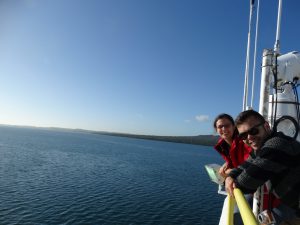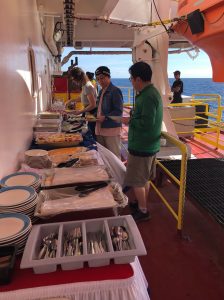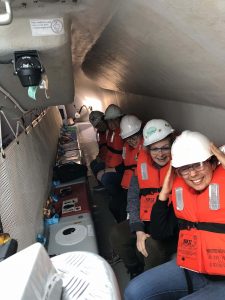Three things I learnt during my first week at sea
I am currently writing this blog post after my first week aboard the JOIDES Resolution. Before this adventure, I had never been at sea for more than 2 hours (!!), so I have been learning a lot about life as a scientist onboard a research vessel.

Here are three things that I have learnt about living and working onboard the JOIDES Resolution over the past week:

1. Everybody on board works 12-hour shifts.
Most scientists work from 12-12 (midday to midnight, or midnight to midday). There is always somebody onboard working, and there is always somebody onboard sleeping! This first week has been a bit tricky, as I have ship lag (as opposed to jet lag). I have been trying to get used to waking up at 10.30 pm and going to sleep at 3 pm!
2. The galley (kitchen) serves wonderful food at all hours of the day!
My favourite meal of the week had to be the outdoor BBQ – the sun was out, the sea was flat, the wind was calm – and we had a super-tasty BBQ in the middle of the ocean!! The JOIDES Resolution has a baker onboard, so one of the highlights of being on the night shift is that we get to eat warm freshly baked cakes for “morning tea” at 3 am! This week I had a banana cake with nuts and chocolate chips that were still melty… YUM!!

3. Lifeboats sure are crowded on the inside!
I have always wanted to see what a lifeboat looks like on the inside (obviously just to sticky-beak – not for an actual emergency!) and this week I got my chance! Much of this first week has been a lot of safety training, including a lifeboat drill. In a regular “abandon ship” drill, we have to get our immersion suits (thick neoprene survival suits with built in mittens which make it tricky to do the main zipper up), our life jackets, our hard hats & safety glasses and head to the lifeboats. After getting our names called off the roll, we got to climb inside a lifeboat to learn how it works. Every bit of space is used. Under the seats, there is room for a motor, emergency rations etc. While it was great fun playing around in the lifeboat, hopefully I’ll never have to use it! 🙂